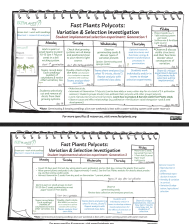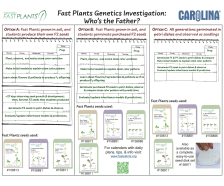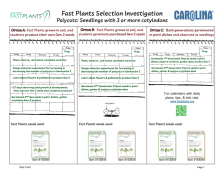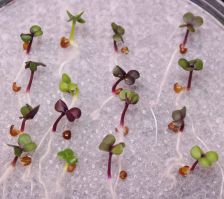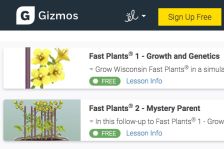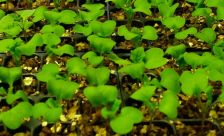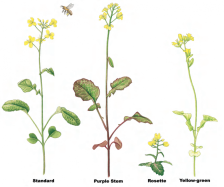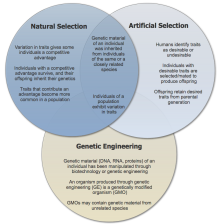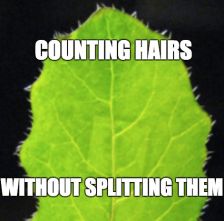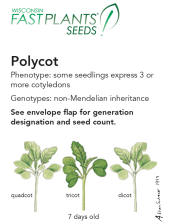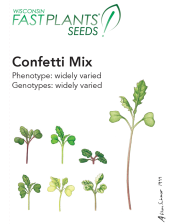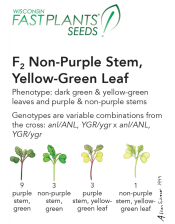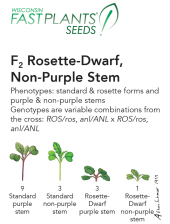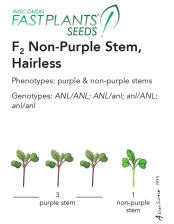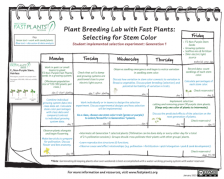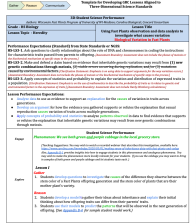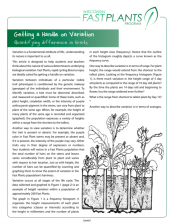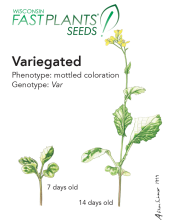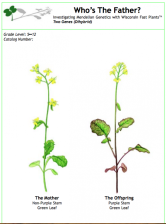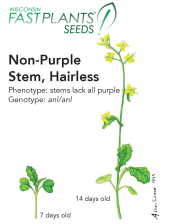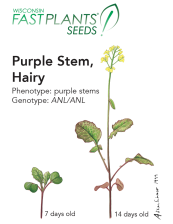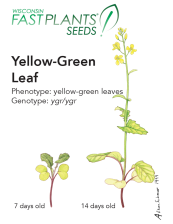Browse Resources
Science -- Inheritance, genetics
Resources | |
|---|---|
This PDF document shows in detail the possible day-to-day learning associated with the 6-week version of the Fast Plants Polycot Selection / Plant Breeding Investigation (aka Option A).
Conducting this selection / plant breeding investigation uses Generation 1 Polycot Fast Plants seed lines, with...
This PDF document shows three calendars side-by-side for comparing the time and materials needed for three different versions of the Fast Plants Mendelian Inheritance Investigation that is commonly called "Who's the Father?"
Option A involves students growing the F1 generation of Fast Plants in...
This PDF document shows in greater detail the possible day-to-day learning associated with the 3-week version of the Fast Plants Polycot Selection Investigation.
Conducting this selection investigation in just 3 weeks involves using Polycot Fast Plants seed lines for both Generation 1 and 2...
This PDF document shows three calendars side-by-side for comparing the time and materials needed for three different versions of the Fast Plants Polycot Selection Investigation.
Option A involves Fast Plants grown in soil, and students select for or against polycots, then produce their own...
This blog post from the Wisconsin Fast Plants features open source educator resources, developed in 2023. These resources support the teaching of genetics concepts with tools focused on a Dihybrid Inheritance Study. This study provides a two-week approach for observing three generations of plant...
This blog post from the Wisconsin Fast Plants features open source educator resources, developed in 2023. These NGSS- and Ag-Standards aligned resources, named Investigating Brassicas Around the World with Fast Plants include a full lesson plan with supporting plant breeding activities, video about...
This blog post on the Wisconsin Fast Plants website features the recently released Wisconsin Fast Plants genetics simulations, powered by ExploreLearning Gizmos. Sign up for a free account on the Gizmo website (https://www.explorelearning.com/index.cfm?method=Controller.dspFreeAccount) for free...
This blog post, written by the MiniPCR Team, describes the use of biotechnology kits and equipment (available from multiple suppliers) in the classroom to help students and learners understand the connection between observable phenotypic traits and underlying genotypes. These investigations can be...
This blog post from the Wisconsin Fast Plants website provides an overview and list of resources for teaching about observable variation and measuring selection (focusing on leaf hairs/trichomes). This blog is primarily a point of reference for other Fast Plants teaching resources.
This blog post from the Wisconsin Fast Plants website provides an overview and list of resources for teaching about heredity and inheritance patterns with Fast Plants seed varieties. This blog is primarily a point of reference for other Fast Plants teaching resources, but includes specific detail...
This blog post from the Wisconsin Fast Plants website provides an overview and list of resources for teaching life science topics with Wisconsin Fast Plants. This blog is primarily a point of reference for other Fast Plants teaching resources.
This blog post from the Fast Plants Team addresses the question "Are Wisconsin Fast Plants Genetically Engineered Plants?". This post describes the origins of Fast Plants (they are the result of conventional plant breeding, not genetic engineering), defines terms related to plant breeding and...
This blog post from the Wisconsin Fast Plants website describes the observation of plant hairs (trichomes) for conducting a selective breeding experiment (such as in AP Biology investigations). The number of hairs is variable in Fast Plants seed varieties, and selection for or against plant...
This is a page on the Fast Plants website, describing the Polycot variety of Fast Plants (Brassica rapa). Two generations of the Polycot variety are available, each with a different % of expression of the polycot trait. This page includes suggestions for investigations and teaching applications...
This is a page on the Fast Plants website, describing the Confetti Seed Mix variety of Wisconsin Fast Plants (Brassica rapa). Confetti Mix includes phenotypes from several Fast Plants varieties, including purple stem, non-purple stem, yellow-green leaf, rosette-dwarf, tall plant, petite, variegated,...
This is a page on the Fast Plants website, describing the F2 Non-Purple Stem, Yellow-Green Leaf variety of Fast Plants (Brassica rapa). This page includes suggestions for investigations and teaching applications using this seed variety, including use as a model organism in teaching Mendelian...
This is a page on the Fast Plants website, describing the F2 Rosette-Dwarf, Non-Purple Stem variety of Fast Plants (Brassica rapa). This page includes suggestions for investigations and teaching applications using this seed variety, including use as a model organism in teaching Mendelian genetics...
This is a page on the Fast Plants website, describing the F1 Rosette-Dwarf, Non-Purple Stem variety of Fast Plants (Brassica rapa). This page includes suggestions for investigations and teaching applications using this seed variety, including use as a model organism in teaching Mendelian genetics...
This is a page on the Fast Plants website, describing the F2 Non-Purple Stem variety of Fast Plants (Brassica rapa). This page includes suggestions for investigations and teaching applications using this seed variety, including use as a model organism in teaching Mendelian genetics with a monohybrid...
This investigation begins with a phenomenon that is evidenced in most every produce aisle: Many of the vegetables that botanists classify as Brassica look and taste different. This investigation aligns with middle and high school Next Generation Science Standards as well as with agricultural science...
This document includes a timeline and calendar to serve as planning tools for teachers to use when figuring out when to begin the steps associated with conducting a two-generation artificial selection experiment using Fast Plants. This investigation focuses on selection for the stem color trait....
In this 26-page investigation—co-developed for secondary grades by teachers, the Wisconsin Fast Plants Program at UW-Madison, The Concord Consortium data scientists, and developers from Carolina Biological Supply, and Brett Moulding—learners investigate variation and inheritance in the “three...
This resource, provided by Wisconsin Fast Plants and CurrikiStudio, contains a set of six different learning activities that can be implemented in classrooms to teach natural selection. Organized in playlists, these interactive lessons guide students through understanding and applying knowledge of...
Sign up for a free account on the Gizmo website (https://www.explorelearning.com/index.cfm?method=Controller.dspFreeAccount) for free access to two simulations that were collaboratively developed by the teams at Explore Learning and the Wisconsin Fast Plants Program of the University of...
This article is designed to help students and teachers think about the nature of various determinants underlying biological variation. Teachers facilitating any selection investigation will find this background information helpful, including those planning for the AP Biology Lab 1 of Big Idea 1:...
This fill-in-the-blank timeline is a planning tool for teachers to use when figuring out when to begin the steps associated with conducting a two-generation artificial selection experiment using Fast Plants. Teachers preparing for any selection experiment will find this timeline helpful, including...
This Farming Fast Plants activity introduces a classroom investigation that is easily adaptable for all grade levels and designed to engage teachers and students as investigators. The activity has the practical outcome of producing an abundant supply of Fast Plants seed for future classroom use and...
This is a page on the Fast Plants website, describing the F1 Non-Purple Stem variety of Fast Plants (Brassica rapa). This page includes suggestions for investigations and teaching applications using this seed variety, including use as a model organism in teaching Mendelian genetics with a monohybrid...
This is a page on the Fast Plants website, describing the Non-Purple Stem, Yellow-Green Leaf variety of Fast Plants (Brassica rapa). This page includes suggestions for investigations and teaching applications using this seed variety.
This is a page on the Fast Plants website, describing the Variegated variety of Fast Plants (Brassica rapa). This page includes suggestions for investigations and teaching applications using this seed variety.
This is a page on the Fast Plants website, describing the F1 Non-Purple Stem, Yellow-Green Leaf variety of Fast Plants (Brassica rapa). This page includes suggestions for investigations and teaching applications using this seed variety, including use as a model organism in teaching Mendelian...
Download the complete instructions for a high school level inheritance and genetics inquiry, using Wisconsin Fast Plants. In this investigation, students gather their own evidence to explain how inheritance works. As they observe three generations of Wisconsin Fast Plants, students unravel a...
This is a page on the Fast Plants website, describing the Non-Purple Stem Hairless variety of Fast Plants (Brassica rapa). This page includes suggestions for investigations and teaching applications using this seed variety.
This is a page on the Fast Plants website, describing the Purple Stem, Hairy variety of Fast Plants (Brassica rapa). This page includes suggestions for investigations and teaching applications for using this seed variety.
This is a page on the Fast Plants website, describing the Yellow-Green Leaf variety of Fast Plants (Brassica rapa). This page includes suggestions for investigations and teaching applications using this seed variety.
| |
